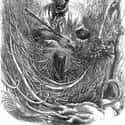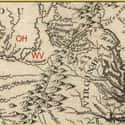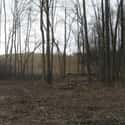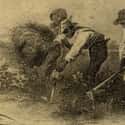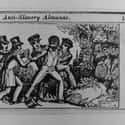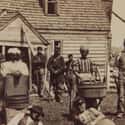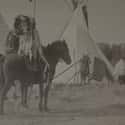-
(#1) The Dismal Swamp Maroon Community Started In 1680 And Was Dominated By Escaped African American Slaves
Archaeologists who've studied the area believe that escaped slaves found refuge in the Great Dismal Swamp starting around 1680, back when America was still a British Colony. The community thrived and grew between then and the Civil War, when the slaves were freed and could join society.
It was dominated by African Americans during this period, although Native Americans, white indentured servants, and others fleeing standard societal norms lived there as well.
-
(#2) Briar Bushes, Soggy Conditions, And Mosquitoes Made The Swamp An Unpleasant Place To Live – But A Great Place To Hide
The swamp now consists of 112,000 acres, but back in the 1600s, it had over 1 million acres of wetlands. The land is filled with prickly briar bushes and water-logged ground. It is home to mosquitoes, snakes – including water moccasins – bobcats, and in the 17th century, even bears.
All of this made it an unpleasant location to call home, but those conditions also kept the determined people who lived there safe from their pursuers.
-
(#3) They Lived On Islands Concealed In The Swamp Where Slave Catchers Couldn't Find Them
The maroon community formed on islands well-hidden deep within the swamp. In fact, it was so well hidden that even historians and archeologists didn't know about it for decades. There was no way of finding the dry ground, until they stepped onto it and realized that it was firm underfoot. The main island that the community lived on consists of 20 acres of mostly dry land – a refuge within the swamp.
Slave catchers, too afraid of walking through the swamp, never ventured there to look for escaped slaves that had a bounty on their heads.
-
(#4) People Also Lived On The Outer Edges And Canal Areas Of The Swamp
Despite the fact that most historians and archaeologists believe that the main part of the maroon community lived on the islands deep within the swamp, there is evidence that some were brave enough to remain on its outskirts. The outer edges of the swamp had rougher terrain, as well as a series of canals that workers dug to control the water in certain parts.
The people living in these areas are believed to have been mostly Native Americans, who didn't need to hide from slave catchers.
-
(#5) Members Of The Community Emerged From The Swamp To Fight In Wars Over The Years
The maroons living in the swamp didn't just hide out there, afraid of being seen again. They emerged from their island cabins to fight in wars against the people who enslaved them in the first place. There are records of them fighting in Lord Dunmore's Royal Ethiopian Regiment during Lord Dunmore's War in 1774 (a pre-Revolution skirmish between Lord Dunmore, then the Governor of Virginia, and the Mingo and Shawnee tribes in what is now the Ohio Valley.)
Maroons also fought for the British during the Revolutionary War, and they fought for the Union during the Civil War.
-
(#6) The Inhabitants Of The Swamp Made Everything They Needed – They Were A Fully Sustainable Society
In order to stay as isolated as possible, the people living in the swamp community made many things by hand, rather than by purchasing commercially made goods. There was another reason for this as well – as outsiders in a private society, they didn't have access to money to purchase these premade goods.
Instead, the items excavated on the main island consisted of fragments of handmade bowls and pipes, as well as animal bone fragments and gun flint.
-
(#7) Some Maroon Societies Raided Local Towns – Not The One In The Great Dismal Swamp
Some maroon communities were very unstable and included escaped enslaved people who wandered around, raiding small towns and villages in order to get supplies and food. Others simply hid deep in the woods (or swamp) where they could avoid detection, and came up with societal standards and farming practices. The people in the Great Dismal Swamp fell into the latter category.
According to a man named Charlie, who later made it to freedom in Canada and had his story written down, the swamp community was set up for communal living and farming – everyone did their fair share of work, and they all received enough food and supplies to survive.
-
(#8) Historians Tended To Overlook Maroon Communities In Favor Of Researching The Underground Railroad
A – potentially implicit or unintentional – racial bias formed among historians who studied slavery in America prior to the Civil War. This bias heavily favored white people's involvement in freeing enslaved blacks, which led to plenty of scholarship on the Underground Railroad – and very little on the maroon communities. After all, the people who formed those communities freed themselves, with little outside help.
Because of this, until recently, maroon communities haven't really been widely studied, and the average person hasn't heard of them.
-
(#9) The Cabins On The Island Held Several Generations Of Escaped Slaves
Archaeologists studied the ground on the main island in the swamp and found the remains of post holes that once supported wooden cabins. Based on these, they were able to determine that the community consisted of numerous cabins, the largest of which were between 15 and 20 feet wide. These cabins supported the many generations of former slaves that lived in them – they didn't just run away to Canada or another free place.
Instead, it is believed (as there are no written records, this is just conjecture) that they lived there for generations, remaining in one place.
-
(#10) Native Americans, Pushed Out Of Their Lands, Helped The People In The Swamp Community
Pottery and stone projectiles, such as large arrowheads, are just two of the things found by archaeologists on the island dig site. Some of the pottery was shattered and placed at the bottom of cabin post holes, most likely to provide additional support. These items are proof that the escaped slaves were not alone out there – they communicated with the local Native American tribes as well.
Encroaching colonial settlements displaced plenty of the tribes in the area, turning them into allies of the people fleeing enslavement.
-
(#11) Human Remains Still Haven't Been Found On The Island, Adding To The Mystery
Although the island is still undergoing excavation, some mysteries remain. One involves where the dead members of the community were buried. To this day, human remains of any kind haven't been found at all, either near the remnants of the cabins or in a traditional cemetery. It's possible that a burial ground does exist, but hasn't been located – or the people who lived there placed their dead elsewhere in the swamp.
-
(#12) The Swamp Community Was Abandoned, But Not Before Its Members Attacked The Confederates In The Civil War
During the Civil War, guerilla fighters from the swamp community attacked Confederate troops in North Carolina, leading the Carolinians to try to find their base deep within the swamp. The guerilla fighters prevailed, as did the Union Army, and once the war ended and the slaves were freed, the people who made up the swamp community left their hiding places.
After years of attempting to stay out of sight, they were finally freedmen and women.
New Random Displays Display All By Ranking
About This Tool
Since the 18th century, countless blacks were trafficked to the southern regions of the United States. Here, black slaves do not exist as independent humans, they were regarded as the property of the plantation owner. A large number of blacks worked hard to do heavy work every day, and were abused by plantation owners, which aroused the resistance of some black slaves, they fled the plantation and hid in the woods or swamps near the plantation.
The Great Dismal Swamp has also become a sanctuary for generations of African-American communities. For centuries, fugitive slaves have been hidden in a vibrant and self-sufficient community and eventually escaped slavery. The random tool introduced 12 facts about the life of escaped slaves who live in a swamp.
Our data comes from Ranker, If you want to participate in the ranking of items displayed on this page, please click here.











